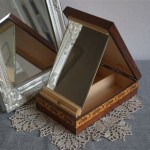Antique Wall Mirrors: A Reflection of History and Style
Antique wall mirrors offer more than just a reflection; they provide a glimpse into the past, showcasing the artistry and craftsmanship of bygone eras. These decorative pieces can elevate a room's aesthetic, adding a touch of history and elegance to any space. Understanding the various styles, materials, and historical contexts of antique wall mirrors can assist collectors and decorators in making informed decisions.
One of the key factors in identifying and appreciating antique mirrors is understanding the different periods and styles they represent. The Georgian period (1714-1830) is known for its elegant and symmetrical designs. Mirrors from this era often feature ornate frames crafted from gilded wood, featuring intricate carvings of leaves, scrolls, and shells. The Victorian era (1837-1901) saw a surge in popularity for elaborate and heavily ornamented mirrors, often incorporating elements of Gothic Revival and Rococo styles. Art Nouveau mirrors, popular from the late 19th to early 20th centuries, are characterized by flowing lines, nature-inspired motifs, and the use of materials like stained glass and pewter.
The materials used in crafting antique mirrors also provide valuable clues to their age and origin. Early mirrors were made using mercury glass, which has a distinctive silvery appearance and can sometimes exhibit signs of aging, such as foxing or spotting. Later mirrors utilized silvered glass, a more durable and less toxic alternative. The frame materials can range from carved wood and gilded gesso to intricately worked metals like brass, bronze, and wrought iron. Examining the materials and construction techniques can help determine the authenticity and value of an antique mirror.
Beyond the aesthetics, the size and shape of an antique wall mirror play a significant role in its impact on a room's decor. Large, ornately framed mirrors can serve as a focal point, adding grandeur and drama to a space. Smaller mirrors can be grouped together to create a gallery wall, showcasing a collection and adding visual interest. The shape of the mirror, whether rectangular, oval, or round, can also influence the overall style and complement existing furniture and decor.
Proper care and maintenance are essential for preserving the beauty and value of antique wall mirrors. Cleaning should be done with care, avoiding harsh chemicals that can damage the delicate frame or mirror surface. A soft, lint-free cloth and a gentle cleaning solution are recommended. Antique mirrors should be hung securely on a sturdy wall to prevent damage from falls. Exposure to direct sunlight and excessive humidity should also be avoided, as these can cause deterioration of the frame and mirror backing.
The value of an antique wall mirror is determined by several factors, including its age, rarity, condition, and provenance. Mirrors from well-known makers or with a documented history can command higher prices. Condition is a crucial factor; mirrors with significant damage or repairs will typically be less valuable than those in pristine condition. Consulting with a reputable antiques appraiser can provide a professional assessment of a mirror's value.
Incorporating antique wall mirrors into a contemporary interior design can add a touch of timeless elegance and create a unique focal point. Mixing antique pieces with modern furniture and decor can create a dynamic and layered look. Choosing the right antique mirror requires careful consideration of the existing decor, the desired style, and the size and shape of the space. Antique mirrors can complement a range of design styles, from traditional to eclectic, adding a touch of history and personality to any room.
When searching for antique wall mirrors, exploring reputable antique shops, auction houses, and online marketplaces can yield a diverse range of options. Carefully examining the mirror's condition, materials, and construction is essential before making a purchase. Asking questions about the mirror's history and provenance can provide valuable insights and ensure authenticity. Acquiring an antique wall mirror is not just a decorative purchase; it's an investment in a piece of history and a testament to the enduring beauty of craftsmanship.
The reflective qualities of antique mirrors also contribute to their decorative appeal. Strategically placed mirrors can enhance the natural light in a room, creating a sense of spaciousness and brightness. They can also be used to reflect interesting architectural details or artwork, adding depth and visual interest to a space. Understanding how to use mirrors to maximize light and enhance the overall design of a room can significantly impact its aesthetic appeal.
Antique wall mirrors represent a tangible connection to the past, offering a glimpse into the decorative styles and craftsmanship of previous eras. From the ornate grandeur of Georgian mirrors to the flowing lines of Art Nouveau designs, each piece tells a story. Whether seeking a statement piece or a subtle accent, antique wall mirrors offer a unique and timeless addition to any interior.

Antique Furniture Vintage French Antiques Mirror Wall Gallery Bedroom

Antique Mirror Wall In 2024 Decor Living Room Apartment

Antique Unique French Style Wall Mirror Osman

25 Sophisticated Antique Mirror Ideas For Your Home Digsdigs Wall Living Room Decor Mirrors

Ornate Antique Gold Wall Mirror Large Israel

Oval Polyurethane Framed Antique Gold Wall Mirror 25x33

Antique Teakwood Wall Mirror Shape Rectangle

Pair Of Small Antique Wall Mirrors Dutch Brass Cushion Mirror Convex

Ornate Antique Gold Wall Mirror Large Hong Kong

Antique Wall Mirror Shape Rectangular








